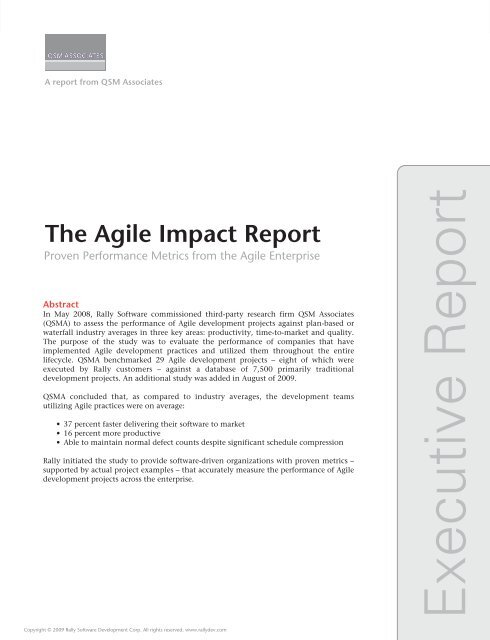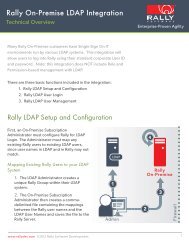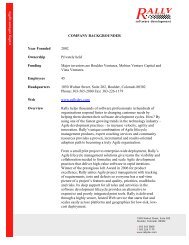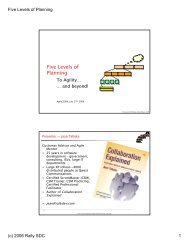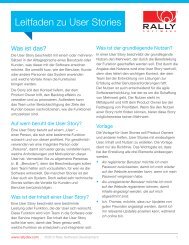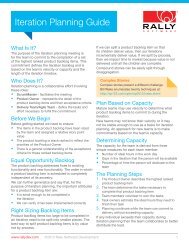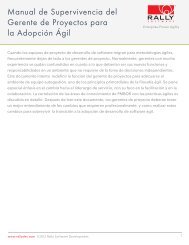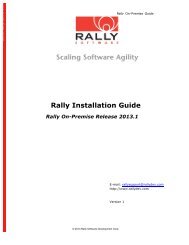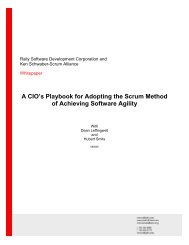The Agile Impact Report - Rally Software
The Agile Impact Report - Rally Software
The Agile Impact Report - Rally Software
Create successful ePaper yourself
Turn your PDF publications into a flip-book with our unique Google optimized e-Paper software.
A report from QSM Associates<br />
<strong>The</strong> <strong>Agile</strong> <strong>Impact</strong> <strong>Report</strong><br />
Proven Performance Metrics from the <strong>Agile</strong> Enterprise<br />
Abstract<br />
In May 2008, <strong>Rally</strong> <strong>Software</strong> commissioned third-party research firm QSM Associates<br />
(QSMA) to assess the performance of <strong>Agile</strong> development projects against plan-based or<br />
waterfall industry averages in three key areas: productivity, time-to-market and quality.<br />
<strong>The</strong> purpose of the study was to evaluate the performance of companies that have<br />
implemented <strong>Agile</strong> development practices and utilized them throughout the entire<br />
lifecycle. QSMA benchmarked 29 <strong>Agile</strong> development projects – eight of which were<br />
executed by <strong>Rally</strong> customers – against a database of 7,500 primarily traditional<br />
development projects. An additional study was added in August of 2009.<br />
QSMA concluded that, as compared to industry averages, the development teams<br />
utilizing <strong>Agile</strong> practices were on average:<br />
<br />
<br />
• 37 percent faster delivering their software to market<br />
• 16 percent more productive<br />
• Able to maintain normal defect counts despite significant schedule compression<br />
<strong>Rally</strong> initiated the study to provide software-driven organizations with proven metrics –<br />
supported by actual project examples – that accurately measure the performance of <strong>Agile</strong><br />
development projects across the enterprise.<br />
Executive <strong>Report</strong><br />
Copyright © 2009 <strong>Rally</strong> <strong>Software</strong> Development Corp. All rights reserved. www.rallydev.com
As <strong>Agile</strong> Goes Mainstream It’s Time for Metrics<br />
Key Disruptive Trends Driving <strong>Agile</strong> Adoption<br />
by Melinda Ballou, Program Director, Application Life-Cycle Management & ITMS, IDC.<br />
Increasingly, organizations create software via a complex, distributed supply chain that spans<br />
organizational boundaries and multiple software sources. As a result, communication between business<br />
stakeholders and a diverse range of IT resources has become increasingly more problematic. With<br />
disparate teams, disparate partners and disparate code sources, how can companies create a coherent,<br />
managed approach?<br />
In this context and that of our current, difficult global economy, the business benefits of <strong>Agile</strong><br />
development approaches become visceral and demonstrable. With highly constrained resources,<br />
organizations have little leeway for the long time-to-market, poor communication, and delayed benefits<br />
that typically accompany traditional waterfall approaches.<br />
As a result, in part, IDC sees <strong>Agile</strong> adoption going increasingly mainstream. <strong>The</strong> disruptive factors of<br />
complex sourcing, regulatory and localization compliance demands, mergers and acquisitions, and<br />
emerging technology issues (such as Web 2.0, SOA and security concerns) have already driven a majority<br />
of organizations towards iterative processes and <strong>Agile</strong> approaches. For companies that remain solely<br />
entrenched in a waterfall approach, the business costs and consequences of long and late software project<br />
cycles are becoming untenable in dynamic, global competitive environments.<br />
Along with increased adoption comes the need for effective metrics to validate the benefits of <strong>Agile</strong> and to<br />
evolve enterprise deployments. Quantitative metrics facilitate qualitative decision-making to sustain<br />
on-going improvements and support <strong>Agile</strong> strategies across groups, departments and divisions.<br />
<strong>The</strong> Potential Benefits of <strong>Agile</strong> – Faster Time-to-Market and Improved Productivity<br />
IDC research indicates that 70-80% of software development failures result from poor requirements<br />
gathering, analysis and management. Proactive, well-managed <strong>Agile</strong> approaches can help to solve those<br />
problems by enabling quick and frequent feedback across the cultural divide between business and IT, and<br />
can also bridge the gap to operations and provisioning. <strong>Agile</strong> engages IT and the business through each<br />
phase to chunk larger initiatives into key segments that can improve time-to-market by delivering quickly<br />
on the initiatives of greatest priority to the business. Where effective, this enables IT teams to support<br />
businesses in being more responsive to emerging, dynamic market needs.<br />
<strong>The</strong> potential for productivity gains are another key driver for establishing <strong>Agile</strong> approaches. Additionally,<br />
the mentoring of new teams by mature <strong>Agile</strong> teams can help establish broader <strong>Agile</strong> adoption and a more<br />
dynamic software development approach for business support. In short, one team’s success with <strong>Agile</strong><br />
development can be an example to lead to organizational adoption and further productivity<br />
improvements by other teams and across the board. It is also useful to establish <strong>Agile</strong> as part of an overall<br />
application life cycle approach. Understanding community collaboration and <strong>Agile</strong> development (from<br />
requirements through test and build) can help evolve organizations beyond current, typical application<br />
creation.<br />
As an example, <strong>Agile</strong>, iterative testing improves quality. In fact, some <strong>Agile</strong> practitioners incorporate<br />
leading Quality Assurance (QA) staff as ScrumMasters to establish strong links between QA and their <strong>Agile</strong><br />
process. Managing relevant data associated with <strong>Agile</strong> projects from an end-to-end perspective provides<br />
context for overall integration, and also for the ways in which the software artifacts meet corporate<br />
policies and address key business needs and workflow.<br />
Coupled with effective process and organizational strategies, <strong>Agile</strong> development can enable the software<br />
ecosystem to become a strategic asset, rather than spawning disparate, sprawling entities that are isolated<br />
from one another and from the business.<br />
1
Measurement of <strong>Agile</strong> <strong>Impact</strong> is Key<br />
Now that <strong>Agile</strong> is becoming mainstream, it is time to move beyond the question of ‘who is adopting<br />
<strong>Agile</strong>?’ and ask ‘what are the quantifiable, measurable benefits of <strong>Agile</strong>?’<br />
Quantifying benefits – such as resource and productivity improvements, cost savings, faster ROI to the<br />
business, increased business focus, improved collaboration and relevance between IT and the business –<br />
facilitates increased adoption of <strong>Agile</strong> practices. However, it’s almost impossible to measure and quantify<br />
benefits without first setting up a baseline – performing a gap analysis – in order to measure the benefits<br />
of <strong>Agile</strong> in relation to an organization’s pre-existing approach (such as waterfall). It is therefore critical to<br />
evaluate existing practices, resource allocation and costs, prior to bringing in an <strong>Agile</strong> approach.<br />
<strong>The</strong> Business Value of a Comprehensive ALM Platform<br />
Successful <strong>Agile</strong> implementations, especially those that span multiple teams and projects, necessitate a<br />
purposeful and proactive strategy across the entire application life cycle. Organizations that seek to knit<br />
together smaller iterative projects across an enterprise deployment need to establish effective<br />
prioritization criteria and decision-making. This often comes in the form of a plan and approach for <strong>Agile</strong><br />
training, support of various ALM products and an internal knowledge sharing, retrospection and<br />
improvement. This can enable adaptive, <strong>Agile</strong> businesses.<br />
Ideally, companies have broad visibility through a coordinated, <strong>Agile</strong> ALM approach. Moving beyond ad<br />
hoc, one-off <strong>Agile</strong> initiatives can support companies to unite what could otherwise be a disconnected<br />
series of projects or sprints. <strong>The</strong> potential benefits to be gained by deploying a comprehensive <strong>Agile</strong> ALM<br />
solution include: faster creation of a richer code base, earlier and faster repair of defects, the incorporation<br />
of key changes, and most importantly, relevant deployments that are well coordinated with business<br />
needs and visibility across the enterprise.<br />
A company’s responsiveness to dynamic, global competitive pressures is particularly critical in a difficult<br />
economy (resulting in part from the sub-prime mortgage and financial crisis, a weak dollar and other<br />
factors). It is all the more important that organizations consider and adopt iterative, <strong>Agile</strong> approaches to<br />
development.<br />
Conclusion/Recommendations<br />
Companies and users should evaluate and leverage <strong>Agile</strong> approaches to software development for<br />
increased collaboration and productivity, faster time to market, improvements to code quality and better<br />
alignment with the needs of the business. Moreover, it is important to measure the benefits of <strong>Agile</strong><br />
initiatives with and against a benchmark of pure waterfall projects. Since <strong>Agile</strong> adoption involves<br />
significant process and organizational change, it is critical to success to focus initially on the human and<br />
cultural issues involved, to perform a gap analysis and transition proactively. Companies making the shift<br />
should establish effective mentoring and process change with pilot teams, and then socialize other parts<br />
of the organization to evolve to a successful <strong>Agile</strong> implementation.<br />
2
<strong>The</strong> <strong>Agile</strong> <strong>Impact</strong> <strong>Report</strong>: Proven Performance Metrics from the <strong>Agile</strong> Enterprise<br />
Background<br />
Objectives and Study Methodology<br />
QSMA used its SLIM (<strong>Software</strong> Lifecycle Management) suite of benchmarking, software estimation and<br />
modeling tools to obtain objective data and benchmark <strong>Agile</strong> development projects against QSMA’s large,<br />
heterogeneous database. <strong>The</strong> SLIM-Metrics database represents over 7,500 projects across 500 organizations in<br />
18 countries and adds between 200 and 400 projects per year.<br />
<strong>The</strong> objectives of the study were to:<br />
• Assess the performance of <strong>Agile</strong> development projects across enterprise teams<br />
• Benchmark <strong>Agile</strong> projects (both those that used <strong>Rally</strong>’s <strong>Agile</strong> lifecycle management solutions and<br />
those that did not) against plan-based or waterfall industry averages for time and effort<br />
• Measure the projects with respect to time-to-market and productivity/quality and benchmark the<br />
approach to consider automating ongoing measurement<br />
Participating Companies<br />
<strong>The</strong> measured projects included in the “<strong>Agile</strong> <strong>Impact</strong>” study represent a variety of industries and project sizes<br />
with sixty to over a thousand <strong>Agile</strong> practitioners. Six <strong>Rally</strong> customers – Accuro Healthcare Solutions Inc., BMC<br />
<strong>Software</strong>, CNET, HomeAway, Inc., Inovis, and Moody’s – contributed data for nine <strong>Agile</strong> development<br />
projects and provided additional information for in-depth case studies.<br />
Accuro Healthcare Solutions Inc. is a leading provider of proprietary Internet-based solutions to a broad range<br />
of healthcare providers, enabling them to more effectively manage the complexities of the patient<br />
registration, billing, collection and reimbursement process. Accuro Healthcare initially adopted <strong>Agile</strong> practices<br />
in early 2008 and brought on <strong>Rally</strong> products and coaching a few months later. <strong>The</strong> company now has over<br />
150 <strong>Rally</strong> licenses and <strong>Agile</strong> practitioners. This study assessed one major release with a schedule of almost two<br />
months with seven full-time employees delivering approximately 168 story cards and was comprised of<br />
roughly 19,675 lines of new and modified code.<br />
BMC <strong>Software</strong> is a leading global provider of enterprise management solutions that empower companies to<br />
automate their IT and align it to the needs of the business. For the four fiscal quarters ended December 31,<br />
2007, BMC revenue was approximately $1.7B. BMC initially adopted <strong>Agile</strong> practices in 2005 and at the same<br />
time brought on <strong>Rally</strong> for its <strong>Agile</strong> lifecycle management products and coaching services. Since then, <strong>Agile</strong><br />
development practices at BMC have spread from a small pilot project to more than 1,000 <strong>Agile</strong> practitioners<br />
dispersed over three international locations. This study assessed two major BMC releases with schedules<br />
ranging from four and a half to five months, 90 – 95 full-time employees delivering approximately 1,450<br />
story cards, comprised of roughly 1.4 million lines of new and modified code.<br />
CNET is where people go to discover the latest in tech and consumer electronics. CNET initially adopted <strong>Agile</strong><br />
practices in 2005, and the company now has 65 <strong>Rally</strong> licenses. This study assessed two major CNET releases<br />
with schedules ranging from three and a half to almost six months with 41 full-time employees delivering<br />
approximately 30,000 lines of new and modified code for complex web applications.<br />
Inovis offers software and services that enable companies to do business electronically across their entire<br />
trading community. Each day, over 20,000 companies across the globe rely on the Inovis Business<br />
Community Management platform to reliably send and receive purchase orders, synchronize data and<br />
manage exceptions in order to lower supply chain costs and get products to customers faster. Inovis adopted<br />
<strong>Agile</strong> and <strong>Rally</strong> at the same time in January of 2008. <strong>The</strong> company now has 170 <strong>Rally</strong> licenses distributed<br />
globally. This study accessed one major release with a schedule of eight months and a peak staff of fifteen<br />
full-time employees delivering 325,871 lines of new and modified code.<br />
HomeAway Inc. is the largest international network of vacation rental web sites with 284,000 paid listings of<br />
rental homes, condos, apartments, villas, cottages and cabins in more than 100 countries. HomeAway<br />
initially adopted <strong>Agile</strong> practices in 2006 and brought on <strong>Rally</strong> products and coaching in 2007. <strong>The</strong> company<br />
now has 70 <strong>Rally</strong> licenses and a similar number of <strong>Agile</strong> practitioners. This study assessed two major<br />
HomeAway releases with schedules ranging from six to seven months with eight full-time employees<br />
delivering approximately 233,000 lines of new and modified code.<br />
3
Moody’s Corporation (NYSE: MCO) is an essential component of the global capital markets, providing credit<br />
ratings, research, tools and analysis that contribute to transparent and integrated financial markets. Moody’s<br />
KMV, a division of Moody’s Corporation, is a provider of quantitative credit analysis tools. Moody’s KMV<br />
initially adopted <strong>Agile</strong> practices in 2006 and brought on <strong>Rally</strong> products and coaching in 2007. <strong>The</strong> company<br />
now has 210 <strong>Rally</strong> licenses distributed globally. This study assessed one major release with a schedule of<br />
almost four months with 30 full-time employees delivering approximately 116,000 lines of new and modified<br />
code.<br />
Additional companies in this study that rely on <strong>Agile</strong> practices, but are not <strong>Rally</strong> customers, are all part of<br />
multi-billion dollar enterprises with large, international client bases and represent a variety of industries and<br />
project sizes.<br />
<strong>The</strong>se include:<br />
• A leading global supplier of medical analytical instruments and technology solutions - Four projects<br />
were studied with peak staff of eight to 15<br />
• A medical IT company that delivers mission-critical healthcare decision support solutions and<br />
software tools - Eight projects were studied with peak staff of five to 65<br />
• A leading international financial services organization that provides diverse insurance protection and<br />
wealth accumulation products - Three projects were studied with peak staff of 26 to 29<br />
• A leading software company that provides universities, libraries, and schools with a wide range of<br />
educational tools and services – Six projects were studied with peak staff of 26 to 39<br />
For the above companies, data was collected from 2005 to 2007 with the exception of one project in 2004.<br />
Only one of the companies had more than two years of <strong>Agile</strong> experience.<br />
<strong>Agile</strong>’s <strong>Impact</strong> on Time-to-Market<br />
<strong>Agile</strong> Projects are 37% Faster to Market than Industry Average; <strong>Rally</strong> Projects are 50% Faster<br />
<strong>Software</strong> development teams, especially when they have large and geographically dispersed teams, often<br />
struggle to deliver their software on time. By adopting <strong>Agile</strong> practices, companies measured in this study were<br />
able to produce large-scale enterprise software in four to eleven months, compared to the six to thirteen<br />
months a typical organization required to deliver comparable software. Overall, <strong>Agile</strong> companies experience<br />
an average increase in speed of 37 percent. <strong>Rally</strong> customers who participated in the study saw an average<br />
increase of 50 percent in their time-to-market when compared to the industry average.<br />
Especially noteworthy is the fact that <strong>Agile</strong> processes succeed in spite of teams being large and geographically<br />
dispersed. According to QSMA’s data, many companies with distributed teams experience longer schedules,<br />
but the companies involved in the study with globally dispersed teams, did not. According to <strong>Rally</strong>’s own<br />
customers, this success is due in large part to the use of <strong>Rally</strong>’s <strong>Agile</strong> lifecycle management products.<br />
Time-to-Market<br />
100<br />
4<br />
<strong>Rally</strong> Projects<br />
<strong>Agile</strong> Companies<br />
QSMA SLIM database<br />
CNET<br />
1 Sigma line<br />
Accuro Healthcare<br />
HomeAway<br />
1 Sigma line<br />
1 10 100 1,000<br />
User Stories, Code (KSLOC)<br />
Moody’s<br />
Inovis<br />
BMC<br />
10<br />
1<br />
Time-to-Market (Months)<br />
Fig. 1<br />
<strong>Agile</strong> Projects are 37% Faster to Market<br />
than Industry Average, <strong>Rally</strong> Projects are<br />
50% Faster
<strong>Agile</strong>’s <strong>Impact</strong> on Team Productivity<br />
<strong>Agile</strong> projects experienced a 16% increase in productivity compared to industry average; <strong>Rally</strong> projects experienced a<br />
25% increase<br />
QSMA’s Productivity Index (PI) is an objective measure of the efficiency that is achieved in building a<br />
software product. It encompasses all of the processes that influence the performance of a team given the<br />
complexity of their task and the development environment. <strong>The</strong> equation that calculates the Productivity<br />
Index takes this conceptual form: Quantity of Function = Process Productivity * Effort * Schedule.<br />
A number of elements contribute to an organization’s Productivity Index, including: tooling and methods,<br />
technical difficulty, personnel profiles, and integration issues. <strong>The</strong> Productivity Index is an aggregate of both<br />
the product and the process, and it quantifies the net effect of all factors that makes one project different<br />
from another. Because of its many different contributing elements, a team’s productivity is often the most<br />
difficult measure for an organization to change.<br />
According to QSMA, productivity metrics for large, globally distributed teams are often lower. This is caused<br />
both by the increased number of lines of communication and lower efficiency of these lines due to time and<br />
distance constraints.<br />
On average, the <strong>Agile</strong> projects measured in this study experienced a 16 percent increase in their teams’<br />
productivity – a significant increase given the different variables included in the PI measurement. <strong>Rally</strong><br />
companies on average saw a 25 percent increase in their teams’ productivity compared to the industry<br />
average.<br />
Team Productivity<br />
35<br />
Moody’s<br />
BMC<br />
30<br />
Accuro<br />
Healthcare<br />
CNET<br />
QSMA<br />
HomeAway<br />
1 Sigma line<br />
Inovis<br />
1 Sigma line<br />
SLIM database<br />
<strong>Rally</strong> Projects<br />
<strong>Agile</strong> Companies<br />
25<br />
20<br />
15<br />
10<br />
5<br />
PI Productivity Index<br />
Fig. 2<br />
<strong>Agile</strong> projects experienced a 16%<br />
increase in productivity compared<br />
to industry average; <strong>Rally</strong> projects<br />
experienced a 25% increase<br />
10 100 1,000<br />
User Stories, Code (KSLOC)<br />
0<br />
5
<strong>Agile</strong>’s <strong>Impact</strong> on Quality<br />
Defect counts mostly steady despite cutting schedules by more than 50%<br />
QSMA’s prior research shows that bug counts rise geometrically as schedules are compressed. Typically, “haste<br />
makes waste”; when large teams cut delivery schedules to four or five months as these teams did, defects will<br />
conservatively exceed industry averages by about four times. Instead, these companies experienced total<br />
defect counts that were significantly better than would be expected under these conditions. In fact, despite<br />
cutting schedules by more than 50 percent, results show the defect counts for the measured projects<br />
remained mostly steady. Two <strong>Rally</strong> customers maintained average defect counts and two customers were on<br />
the upper end of industry averages when compared to similar sized projects taking more than twice as long to<br />
deliver.<br />
Defects<br />
10,000<br />
<strong>Rally</strong> Projects<br />
<strong>Agile</strong> Companies<br />
1 Sigma line<br />
CNET<br />
QSMA SLIM database<br />
1 Sigma line<br />
Moody’s<br />
HomeAway<br />
BMC<br />
1,000<br />
100<br />
10<br />
Defects<br />
Fig. 3<br />
Despite Dramatic Schedule Compression,<br />
<strong>Agile</strong> Projects Maintained Normal Defect<br />
Counts<br />
1 10 100 1,000<br />
User Stories, Code (KSLOC)<br />
1<br />
It is important to note that the study did not measure when defects were captured and fixed during the release<br />
cycle. Neither did the study track how many defects were open at any one time. It is common for <strong>Agile</strong><br />
projects to have a large impact on these two metrics over test-last development processes.<br />
<strong>Agile</strong> projects use short time boxes to produce potentially shippable code. A two-week iteration will<br />
implement new stories, but it will also fix high priority bugs, re-factor existing code and add new tests to the<br />
regression suites that validate the stories are ready for acceptance. Along with <strong>Agile</strong> engineering practices such<br />
as continuous integration and test-driven development, these behaviors promote a “fail fast” philosophy<br />
where expensive defects are typically discovered and fixed earlier and more evenly throughout the release<br />
cycle. While not always lowering the total number of defects found in a given amount of code, these<br />
techniques enable teams to respond to flaws before they can negatively impact release dates and the customer<br />
experience. Another benefit is that <strong>Agile</strong> teams can have significantly lower open defect counts and their<br />
associated management overhead.<br />
<strong>The</strong> one downside of <strong>Agile</strong> projects being far less “defect-driven” is that classic defect metrics used to manage<br />
the release end game can become irrelevant. For example, when there are few open defects, charting defect<br />
find and fix rates in hopes of forecasting a ship date no longer provides useful information. Instead, these<br />
reports are replaced by questions into which failing tests or bugs stand in the way of accepting specific stories<br />
as “done.” This change can take some adjustment and may require new ways of reporting release readiness.<br />
6
Conclusion<br />
QSMA’s landmark study resulted in unprecedented productivity and time-to-market metrics for major <strong>Agile</strong><br />
development initiatives at enterprises with varying levels of team and project sizes. Through the adoption of<br />
<strong>Agile</strong> practices supported by lifecycle management tools, many with coaching from <strong>Rally</strong>, companies<br />
involved in the study were on average 37 percent faster delivering their software to market and increased<br />
their teams’ productivity by 16 percent. <strong>The</strong>se improvements were achieved while maintaining total defect<br />
counts in line with traditional projects that took over twice as long to deliver similar functionality. All of the<br />
companies involved in the study continue to scale <strong>Agile</strong> practices across their organization and improve their<br />
agility by inspecting and adapting their processes.<br />
About <strong>Rally</strong><br />
<strong>Rally</strong> is the leader in <strong>Agile</strong> application lifecycle management (ALM) dedicated to making distributed<br />
development organizations faster and leaner by dramatically cutting the time, cost and effort needed to deliver<br />
high quality applications. <strong>Rally</strong>'s products were honored with four consecutive Jolt awards (the software<br />
industry's equivalent of the Oscar® award) in 2006, 2007, 2008 and 2009. <strong>The</strong> company's end-to-end solutions<br />
for <strong>Agile</strong> development also include <strong>Agile</strong> University, the largest source for <strong>Agile</strong> training, and <strong>Agile</strong> Commons,<br />
the largest collaborative Web 2.0 community dedicated to advancing software agility. <strong>Rally</strong> currently supports<br />
more than 1,800 corporate customers, 48,000 projects and 75,000 users in 50 countries. For more information,<br />
visit www.rallydev.com.<br />
About QSMA<br />
QSM Associates, Inc. helps organizations measure, plan, estimate and control software projects. QSMA offers<br />
the SLIM (<strong>Software</strong> Lifecycle Management) Suite of tools, so managers can benchmark and forecast <strong>Agile</strong>,<br />
waterfall, in-house, and offshore/multi-shore software projects. SLIM contains statistics from a worldwide<br />
database of more than 7,500 completed projects, enabling productivity benchmarking on the desktop.<br />
Using SLIM to dynamically run ‘virtual project simulations,’ companies routinely model and forecast<br />
waterfall and <strong>Agile</strong> releases to deliver on time, within budget with > 90% estimation accuracy. SLIM can also<br />
derive ROI achieved by <strong>Agile</strong> methods and other process improvements. QSMA offers consulting, training,<br />
and coaching to help accelerate this capability. For more information, visit www.qsma.com.<br />
QSM and SLIM are registered trademarks of Quantitative <strong>Software</strong> Management.<br />
Appendix Notes<br />
In 2007, BMC <strong>Software</strong> independently commissioned QSM Associates (QSMA) to assess their <strong>Agile</strong> performance.<br />
Results from that study have been included in the most recent study conducted by QSMA on <strong>Rally</strong>’s behalf.<br />
7


